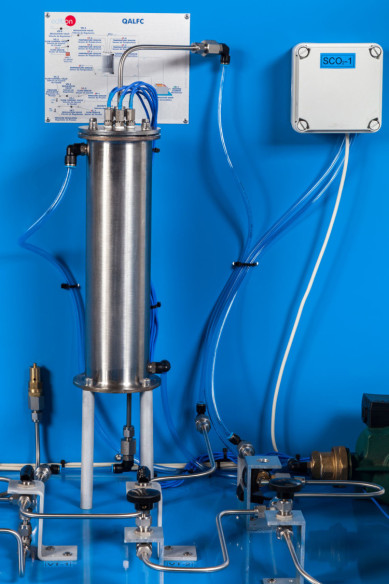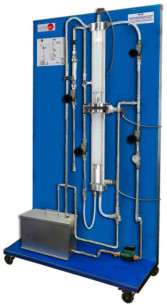QALFC Peralatan Adsorpsi Lapisan Tetap, Dikendalikan dari Komputer (PC)
SISTEM INOVATIF
The Computer Controlled Fixed Bed Adsorption Unit, "QALFC", is designed to demonstrate the gas adsorption phenomenon using a fixed adsorption column.
Ekspansi
Laboratorium
BERITA TERKAIT
GAMBARAN UMUM
The Computer Controlled Fixed Bed Adsorption Unit, "QALFC", is designed to demonstrate the gas adsorption phenomenon using a fixed adsorption column. The overall objective of this unit is to analyze the behavior of the adsorption breakthrough and desorption elution curves associated with the separation of CO2 from Helium using activated carbon. The equilibrium adsorption capacity of this activated carbon will be determined from this analysis and used to model the experimental breakthrough and elution curves.
The gas mixture (composed by CO2 and Helium) is fed from compressed gas cylinders to the column with two pressure regulators. Two flow sensors and two regulation valves are included to measure and regulate the CO2 and Helium inlet flows. The lines include two flow control valves to limit the CO2 and Helium flow.
The fixed bed adsorption column is jacketed for the purpose of thermal control and the adsorbent, activated carbon, is packed. Six temperature sensors with different lengths are located inside the column to measure the adsorption and desorption temperatures.
A column bypass is included for system calibration purposes. This column has two 3-way directional valves, which divert the gas stream between the fixed bed adsorption column and the bypass. A valve at the column's outlet is used to control the pressure in the circuit. This pressure is measured by a pressure sensor. The unit is protected against overpressure by a security valve.
The column is thermally controlled by hot water, which is heated by a system consisting of a thermostatic bath with a heating element and a water pump. An additional temperature sensor is located in the thermostatic bath.
The gas mixture, after passing through the column or the bypass, is divided. A part of the gas mixture passes through an infrared CO2 sensor to measure the CO2 concentration at the column or bypass outlet. A third flow sensor measures the flow entering the CO2 sensor and a regulation valve regulates the gas mixture flow in the flow sensor. This line includes a flow control valve to limit the gas mixture flow. The rest of the gas mixture is discharge to the atmosphere.
This Computer Controlled Unit is supplied with the EDIBON Computer Control System (SCADA), and includes: The unit itself + a Control Interface Box + a Data Acquisition Board + Computer Control, Data Acquisition and Data Management Software Packages, for controlling the process and all parameters involved in the process.
LATIHAN DAN PRAKTEK PEDOMAN
LATIHAN PRAKTIS YANG DIANDAL TERMASUK DALAM PANDUAN
- Study of the Solute Movement Theory model described by the adsorption-desorption process.
- Study of adsorption/desorption processes under different operational conditions such as temperature, pressure, flow rate and molar fraction.
- Study of the breakthrough curves of CO2 and the temperature profiles during the adsorption/desorption processes.
- Study of the quasi-isothermal regime at low concentrations and pressures. Study of the effect of these variables.
- Familiarization with the formation of the compressive and dispersive fronts in adsorption processes.
- Sensors calibration.
LEBIH BANYAK LATIHAN PRAKTIS YANG AKAN DILAKUKAN DENGAN UNIT
- Obtaining of the adsorption equilibrium isotherm of CO2 from the desorption curve.
- Many students view results simultaneously. To view all results in real time in the classroom by means of a projector or an electronic whiteboard.
- Open Control, Multicontrol and Real Time Control.This unit allows intrinsically and/or extrinsically to change the span, gains, proportional, integral, derivative parameters, etc, in real time.
- The Computer Control System with SCADA and PID Control allow a real industrial simulation.
- This unit is totally safe as uses mechanical, electrical/electronic, and software safety devices.
- This unit can be used for doing applied research.
- This unit can be used for giving training courses to Industries even to other Technical Education Institutions.
- Control of the QALFC unit process through the control interface box without the computer.
- Visualization of all the sensors values used in the QALFC unit process.
- By using PLC-PI additional 19 more exercises can be done.
- Several other exercises can be done and designed by the user
PERALATAN KOMPLEMENTER
Peralatan Kolom Absorpsi Gas
Peralatan Kolom Absorpsi Gas Film, Dikendalikan dari Komputer (PC)
Peralatan Laboratorium Adsorpsi dengan Tekanan Berosilasi
Peralatan Pengeringan Udara melalui Adsorpsi, Dikendalikan dari Komputer (PC)
Pabrik Pencuci Gas, Dikendalikan dari Komputer (PC)
Peralatan untuk Studi Aliran dalam Kolom Pengisi, Dikendalikan dari Komputer (PC)
Peralatan Adsorpsi, Dikendalikan dari Komputer (PC)
KUALITAS

LAYANAN PURNA JUAL

 Preferensi cookie
Preferensi cookie





























